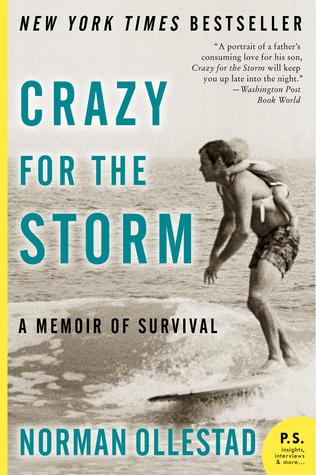The Strengths and Scars of an Extraordinary Childhood
My father and I recently had a phone conversation about books. A fan of mystery novels, he politely voiced a lack of interest in some recent reading suggestions by yours truly. I would note, too, that some of those recommendations have been written about here. I responded by proposing something different, something that could open a discussion about being a son and being a father. The book I recommended is Norman Ollestad’s Crazy for the Storm: A Memoir of Survival. Published in 2009 and lauded as one of the best books of that year, it garnered numerous awards. It tells a the story of a most unusual childhood. It is well-neigh impossible to be a father and not think about one’s own parents and children after reading it.
Norman Ollestad grew up as a child of divorce in a California beach town. His mother provided much of his direct day-to-day support. Her second husband was a complicated character, a caring man who could turn violent when he drank. He was a source of concern, a threat and a less-than-ideal father. It was Norman’s biological father, Norman Sr., who loomed throughout his childhood. A larger than life figure, he is rightfully the key figure in the book, too. Norman, Sr., pushed his son, challenged him, and through his choices nearly killed him – and it was his father’s loves and obsessions, in part, that kept Norman, Jr., alive. Norman, Sr. was a character out of a novel, a man who lived in extremes. A child actor, he later became an FBI agent, an author who challenged FBI Director J. Edgar Hoover, and then a lawyer. Norman Ollestad, Sr., poured much of his energy and enthusiasms into his son. He was dangerous, restless, ambitious, difficult, and admirable.
The book is written in first-person – as a small child, as an eleven year old, as an adolescent and as an adult, reflecting on his life. Throughout the book and the narrator’s ages, Ollestad writes to us with the perspective and skill of an adult who knows his way around words and sentences. The voice and the self-hood of Norman, Jr., remains constant throughout. He tells us of early memories, of life by the beach in Topanga, California, of family together and apart, of friends and of surfing. Norman, Sr., was a surfer. The book cover features a photo of father surfing with his one year old son hanging on his back. Norman, Sr., also challenged Norman, Jr., to ski, to play hockey, and to do so competitively at a high-level. The boy did well, too. A skiing champion and terrified at times, he fought through his fears in great part because of his dad’s hands-off urging. His father was the antithesis of a helicopter parent, instead opting for dares and challenges. Life with Norman, Sr., was intense.
In 1979, after Norman won a ski championship, father, his girlfriend and son took a chartered Cessna that crashed in the San Gabriel mountains. All perished save Norman, Jr., who was able to fight his way through a blizzard and terrible conditions to reach safety. That crash and its trauma are linchpins in the book and in Norman’s life. He was able to persevere, in great part, because of the traits developed by his father. Dad said “never give up” and the son simply could not, not matter what the circumstances. The book’s very title references survival from the crash, but other kinds of struggles are captured: from the many stresses that took place before and after. Surviving this childhood was no easy matter.
Ollestad’s writing is strongest when it comes to physical description, especially the movement of his body. His accounts of surfing, of climbing and falling, of skiing through gates, of the many ways that he had to move and adjust his body, are outstanding. I slowed while reading them. It was easy imagining the motions and feelings as he did. It is gripping prose, crafted with care.
The memoir is less strong when Ollestad tries to make sense of the deep conflicts that shaped his childhood. His father’s love, his desire for his son to be more than a son – almost a peer – carried with it great weights. Does anyone ever truly want their father to call them “Boy Wonder?” Being Norman Ollestad, Jr., was difficult. As a teen Norman had countless issues of rage and confusion. Some stemmed from the trauma of the crash, to be sure. Others were more a result of the terribly complicated childhood he navigated. It is difficult to tell a story and be outside of the story at the same time. Ollestad comes close a few times in the book, and when he does, Crazy for the Storm is telling.
Norman, Jr., closes the book with observations of his own parenting. He, too, taught his son to surf and ski. But Ollestad consciously pulls back, though, when it comes to pushing his son to extremes. He has learned and come to realize, over the years and through the book, the power and danger of his father’s love. Love can be expressed in many different ways.
I’m optimistic that my father will read it, for I am most interested in his take on the book. Come to think of it, I’d like to see if my grown children might read it, too. Crazy for the Storm is quite the memoir.
David Potash
